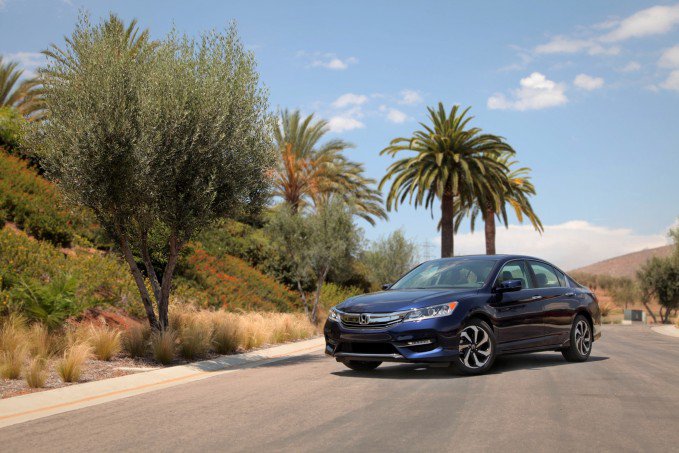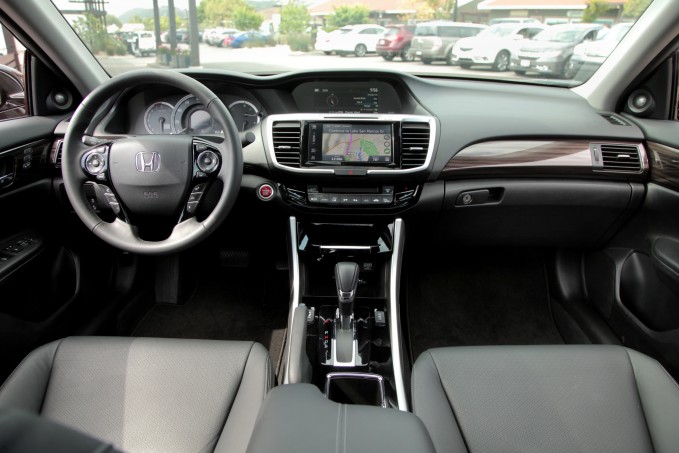The Honda Accord has long been one of the benchmarks for family sedans. Typically a “boring” segment occupied by such stalwarts as the Toyota Camry, Nissan Altima, Ford Fusion, and Hyundai Sonata, Honda knows it’s not going to get away with being lazy. This is a high-volume, competitive segment, and to try to keep its spot near the top of the sales charts, the 2016 Honda Accord has undergone a mid-cycle refresh to make it the most advanced and technology-packed Accord ever. Safety has become the Accord’s main focus, but it hasn’t forgotten about driving dynamics, either.
Typically trailing just behind the Toyota Camry in sales, the new Accord will come with a lot of technology not available on the popular Camry. One of the biggest differences is that the refreshed Accord will be the first Honda available with Apple CarPlay and Android Auto compatibility. Toyota has worked with Ford to develop a different system for smartphone integration, so it likely won’t be putting the Apple or Android systems into its cars in the near future.
Another advantage the Accord has over the Camry is a Honda-exclusive LaneWatch system. When the right-turn indicator is on, it activates a little camera on the passenger side mirror that relays a video of what’s happening in the blind spot to the screen on the center console. This system is a fantastic invention that is actually extremely useful, and Honda’s the only automaker to have something like this. A back-up camera is also standard on all Accords.
Get the Flash Player to see this player.
New Safety Equipment
A package of active safety equipment called HondaSensing will be available on all Accord models, except the Touring trim, which has the equipment standard. Here’s a look at what HondaSensing includes:
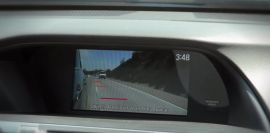
-Lane-keep assist: Uses cameras to read lane markings to help drivers stay in the middle of their lane between 45 mph and 90 mph. If the driver is drifting out of their lane without the turn signals activated, the Accord will sound off a warning and then gently correct the steering if the driver doesn’t do it.
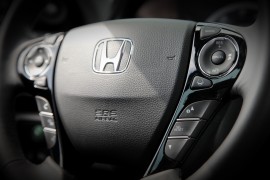
-Adaptive cruise control: Uses radar to keep a safe distance between the Accord and the car in front of it. Drivers can adjust how closely they want to follow another car before the Accord either brakes or speeds up to maintain a safe distance.
SEE ALSO: 2015 Toyota Camry vs. 2015 Honda Accord
Of course, these systems worked wonders on my test drive in sunny and drought-dry California, but even Honda warns that the system’s accuracy is heavily dependent on weather conditions. The Camry offers a lot of the same collision warnings/alerts and braking systems that the Accord does, but it doesn’t have the ability yet to mitigate crashes by offering corrective steering inputs. This can make a huge difference if safety is at the top of your buying requirements.
Updating Styling
The 2016 Accord gets a bunch of exterior updates starting with more chrome on the front fascia, new wheels, new headlights and tail lights, tweaked front and rear bumpers and more LEDs. It still looks like an Accord, but it gets nipped and tucked all around so it’s a little bit sharper than it used to be. “Aggressive” is always an overstatement in the realm of family sedan design, but Honda got this design mostly right by trying to actually avoid the fake super-aggro looks so many cars and crossovers can’t pull off (hello, Lexus).
I like the Honda’s new look, besides the new chrome on the front fascia. I like that the Accord coupe kept the chrome to a minimum and I think Honda should have made the same call with the sedan. Otherwise, the Accord looks smart and sporty, professional and reserved.
Inside the New Accord
The Accord unfortunately sticks to its annoying two-screen, button-less infotainment setup. The lack of a proper volume knob is one thing automakers do that drives me nuts. Besides that one idiosyncrasy, though, the Accord’s interior is comfortable, quiet and well-built.
All the points you touch feel substantial and purposeful.
Bluetooth is standard and the new seven-inch touchscreen (standard on EX models and higher) understands smartphone gestures so you can pinch to zoom, swipe to flip through menus, and tap to make a selection. The infotainment interface isn’t the most user-friendly system out there, but it’s also not a nightmare to use. It takes a little bit of fiddling with before it becomes easy to use. Lower LX trims don’t get a touchscreen, which is a shame, considering they are available on much cheaper cars, but hey, at least you get a volume knob. Touchscreens should really be standard in today’s cars.
The trunk in the sedan also grows by 1.1 cubic feet for a total of 15.8 cu. ft. Accords also get optional heated rear seats and a new 60/40 split/folding rear seat to store extra long items, but the LX trim and the Accord coupe are still stuck with the one-piece folding rear seat back. The sedan is roomy and comfortable for both the driver and the passengers, sightlines are good and there’s no grating ergonomic issues.
No Powertrain Upgrades
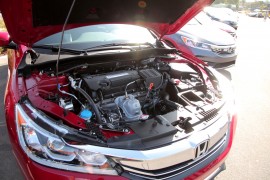
Because no big powertrain changes have been made, fuel economy for the four-cylinder with the CVT stays about the same at 27 mpg city, 37 highway and 31 combined. The V6 with the six-speed automatic rings in at 21 mpg city, 34 highway, 26 combined.
ALSO SEE: 2016 Honda Civic Spied Inside and Out
Available transmissions include a CVT, a six-speed automatic on higher trims or a six-speed manual. Yes, Honda is defying convention by still offering its family sedan with a manual. Even though the take rate for the manual will undoubtedly be low, Honda should be given on pat on the back for still offering it. Honda manuals are some of the slickest and most smooth shifting ones out there, and it would truly signal the end of an era when Honda stops offering them. Camrys are only offered with a six-speed auto. Honda is also still offering the Accord as a coupe, something no other automaker is doing any more.
How Does the New Accord Drive?
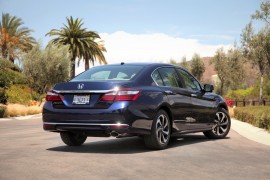
The four-cylinder engine will be sufficient for most people’s driving needs, but the power peaks higher in the rev range, so it requires a bit of patience. If you want a more “exhilarating” drive, definitely upgrade to the V6.
Honda has made some tweaks to its already smooth CVT so that it’s more responsive and more linear in how it gets power to the road, nearly eliminating that rubber band feeling so many people complain about. The body has also been made a bit more rigid, which will help with handling, and Honda has re-tuned the electric steering so that it isn’t as light and floaty as it used to be. It definitely feels more connected than it used to.
Driven on the winding canyon roads in Southern California, the Accord was remarkably composed. I thought it was going to be a bit ambitious for Honda to suggest we drive these roads best suited for BMW M3s, little Miatas and motorcycles, but it got the point across the the Honda hasn’t forgotten how important driving dynamics are.
The Verdict: 2016 Honda Accord Review
The refreshed Honda Accord gets a lot right. Packed with new class-leading safety technology, it’s also important to note that the Accord hasn’t forgotten about driving dynamics, either.
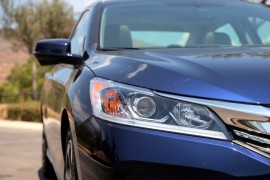
The 2016 Honda Accord sedan will start arriving in showrooms in August 19 and the coupe goes on sale August 26. Pricing for the sedan in the U.S. starts at $22,105 and tops out at $34,580. Coupe pricing starts at $23,775 and tops out at $34,125 (prices don’t include the $820 destination fee).
Discuss this story on our Honda Accord Forum







